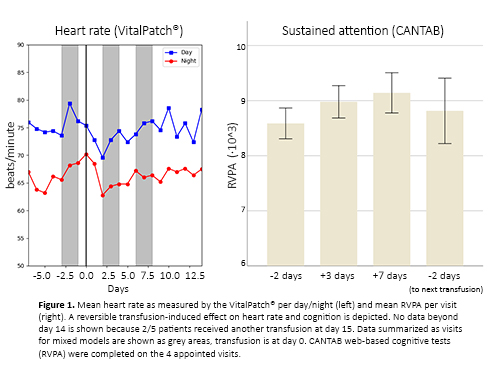
Contributions
Abstract: EP1348
Type: E-Poster Presentation
Session title: Transfusion medicine
Background
Optimising red cell transfusion requires an understanding of both the risks and the benefits. Adverse events of red cell transfusions, like transfusion reactions and iron overload are reasons for considering a restrictive transfusion strategy. However, there are no completed trials in the outpatient setting for chronic transfusion-dependent patients, and little data in general about the value of outpatient transfusions. With no objective parameters to measure the benefits of red cell transfusions, a restrictive transfusion strategy may not be optimal for patients who require RBCT on a regular basis. Transfusions are ordered primarily based on haemoglobin concentrations and a subjective interpretation of symptoms of anaemia. Endpoints that may be more clinically relevant include quality of life measurements, vital signs, functional activity and cognition. To date, there has been little systematic assessment of tools that assess these measures and no published trials that have examined the impact of transfusions on functional outcomes in transfusion-dependent patients.
Aims
The aim of this study is to understand how wearable devices and web-based testing can be used to measure physiological changes and functional activity in a cohort of transfusion-dependent patients.
Methods
We monitored 5 patients who chronically receive transfusions during one transfusion cycle with the VitalPatch® and Withings Steel HR. Patients completed CANTAB cognitive tasks, QUALMS and PROMIS quality of life questionnaires through web-based testing. Outcomes were first the quality and usability of data. Second, we leveraged mixed models to evaluate transfusion-induced changes in 1) heart rate, 2) activity, 3) sustained attention, and 4) patient-reported quality of life.
Results
Captured data was 97,8% high quality and usable for the VitalPatch; 98,9% for the Withings Steel HR. The sent out web-based CANTAB tasks and questionnaires were all completed on the appointed days. Heart rate and sustained attention are significantly and reversibly affected by RBC transfusions, corrected for predefined confounders (Fig. 1): Mean daytime heart rate was 76.5±2.8 bpm before and 72.3±2.8 after transfusion (P=0.002). Sustained attention (RVPA) increased from 8586±140 to 9141±183 after transfusion (P=0.004). Activity and quality of life measures did not yield transfusion-induced changes. The measured activity data may not be representative as the study was conducted during the COVID-19 induced lockdown.

Conclusion
AccelerateIQTM, Withings Steel HR and the CANTAB platform are usable for extracting and analysing data. Red cell transfusions significantly and reversibly decrease heart rate and increase sustained attention in our cohort of 5 red cell transfusion-dependent patients.
Keyword(s): Quality of life, Transfusion
Abstract: EP1348
Type: E-Poster Presentation
Session title: Transfusion medicine
Background
Optimising red cell transfusion requires an understanding of both the risks and the benefits. Adverse events of red cell transfusions, like transfusion reactions and iron overload are reasons for considering a restrictive transfusion strategy. However, there are no completed trials in the outpatient setting for chronic transfusion-dependent patients, and little data in general about the value of outpatient transfusions. With no objective parameters to measure the benefits of red cell transfusions, a restrictive transfusion strategy may not be optimal for patients who require RBCT on a regular basis. Transfusions are ordered primarily based on haemoglobin concentrations and a subjective interpretation of symptoms of anaemia. Endpoints that may be more clinically relevant include quality of life measurements, vital signs, functional activity and cognition. To date, there has been little systematic assessment of tools that assess these measures and no published trials that have examined the impact of transfusions on functional outcomes in transfusion-dependent patients.
Aims
The aim of this study is to understand how wearable devices and web-based testing can be used to measure physiological changes and functional activity in a cohort of transfusion-dependent patients.
Methods
We monitored 5 patients who chronically receive transfusions during one transfusion cycle with the VitalPatch® and Withings Steel HR. Patients completed CANTAB cognitive tasks, QUALMS and PROMIS quality of life questionnaires through web-based testing. Outcomes were first the quality and usability of data. Second, we leveraged mixed models to evaluate transfusion-induced changes in 1) heart rate, 2) activity, 3) sustained attention, and 4) patient-reported quality of life.
Results
Captured data was 97,8% high quality and usable for the VitalPatch; 98,9% for the Withings Steel HR. The sent out web-based CANTAB tasks and questionnaires were all completed on the appointed days. Heart rate and sustained attention are significantly and reversibly affected by RBC transfusions, corrected for predefined confounders (Fig. 1): Mean daytime heart rate was 76.5±2.8 bpm before and 72.3±2.8 after transfusion (P=0.002). Sustained attention (RVPA) increased from 8586±140 to 9141±183 after transfusion (P=0.004). Activity and quality of life measures did not yield transfusion-induced changes. The measured activity data may not be representative as the study was conducted during the COVID-19 induced lockdown.

Conclusion
AccelerateIQTM, Withings Steel HR and the CANTAB platform are usable for extracting and analysing data. Red cell transfusions significantly and reversibly decrease heart rate and increase sustained attention in our cohort of 5 red cell transfusion-dependent patients.
Keyword(s): Quality of life, Transfusion


